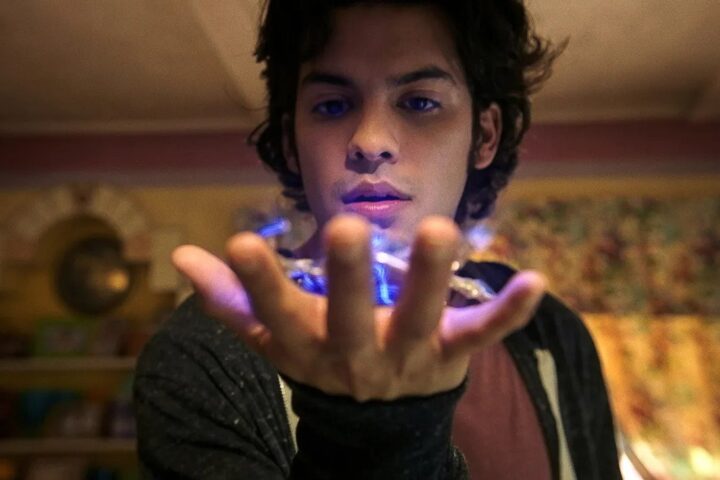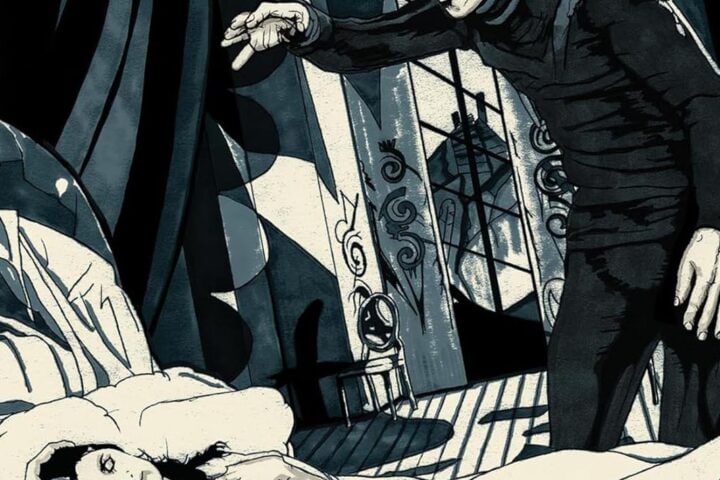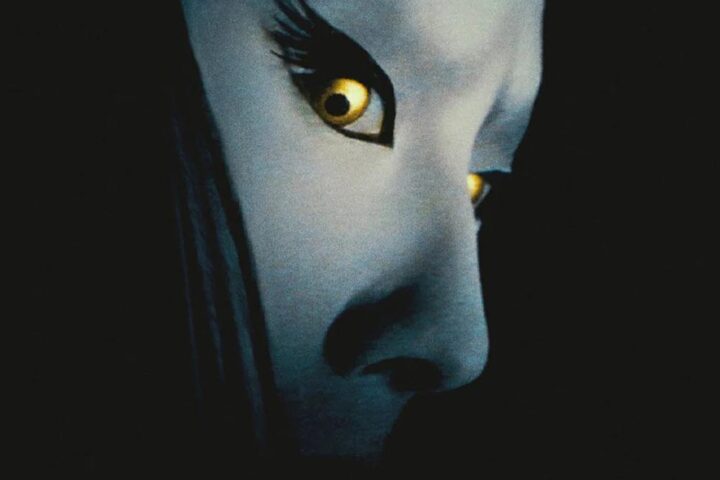Prompted by the massive success of the gothic soap opera Dark Shadows, ABC released dozens of thrillers and horror movies under their Movie of the Week banner between 1969 and 1975. Starting in 1973, the network branched out into late-night programming intended to compete with talk show king Johnny Carson over on NBC, and the five feature-length telefilms collected as The Classic Ghosts by Kino Cult originally aired in that slot.
These telefilms were shot live on two-inch tape in a manner akin to daytime dramas, which does lead to the occasional flubbed line of dialogue. Furthering the comparison, two of the movies were directed by Lela Swift, who helmed over half of Dark Shadows’s approximately 1,200 episodes. Gloria Monty, who directed two others, went on to radically reshape the floundering soap General Hospital in the late ’70s. It’s notable that the creative team behind the telefilms were mostly women. Besides directors Swift and Monty, the films were produced by Jacqueline Babbin, who had shepherded the TV movie Sybil starring Sally Field.
The first four films in the set take often loose inspiration from classics of the ghost story genre. Based on Henry James’s “The Romance of Certain Old Clothes,” The Haunting of Rosalind is a fascinating character study that examines the baleful influence of jealousy, greed, and sexual repression. The story begins with the rivalry of two sisters—younger, prettier Dita (Susan Sarandon) and spinsterish Rosalind (Pamela Payton-Wright)—for the hand of Arthur Lloyd (Frank Converse), the friend of their black-sheep brother, Bernard (Dennis Higgins).
With a literate and slyly suggestive script by Art Wallace and some impressively baroque set and costume designs, this Swift-directed telefilm works moody wonders given its time and budgetary constraints. The slow pans and zooms in and out of mirrors disconcertingly blur the boundary between image and reality. The cinematography makes great use of inky black shadows. All of these elements come together satisfyingly in the expertly staged climactic scene.
Based on the short story by F. Marion Crawford, the Monty-directed The Screaming Skull is a more grisly affair. Unhappily married craniologist Dr. Lucas Pratt (David McCallum) hears a gruesome story from his gregarious older brother, Ollie (Vincent Gardenia), about a novel method of spousal disposal involving molten lead and an unguarded ear, which Lucas soon puts into (mal)practice on his shrewish wife, Helen (Carrie Nye). Not long after Helen’s skull takes its place as part of Lucas’s prized collection, it starts exhibiting a willful life of its own, with a pesky habit of turning up in places where it’s least expected.
The Screaming Skull remains static and somewhat talky for its first half. And it certainly strains credulity that Gardenia and McCallum are actually brothers, an impression that’s only compounded by their radically different acting styles. But once the ghostly phenomena kick in, there are some chillingly effective moments. The effects work on the randomly appearing skull make excellent use of eerily colored gel lighting. And the aftermath of McCallum’s horrific demise is a bit more graphic than you might expect from TV of the time.
Based on Fitz-James O’Brien’s story “What Was It? A Mystery,” Deadly Visitor follows aspiring writer Jamie (Perry King) as he moves into the boardinghouse of Mrs. Moffat (Gwen Verdon), only to be given a room in which he’s violently assaulted by an unseen presence. Enlisting the aid of fellow residents, sculptor Virgil (James Keach) and medical student Mulvaney (Stephen Macht), Jamie tries to figure out the true nature of his assailant.
Like its source material, Deadly Visitor remains ambiguous about exactly what it was. Where O’Brien’s story suggests that the invisible intruder is some kind of ghoul or otherworldly entity, its Swift-directed TV adaptation links its apparition to more human concerns, specifically the vicissitudes of love and the desire for retribution. Interestingly, the likeliest suspects turn out to be women: either a girl who killed herself when Jamie spurned her love, or a housewife murdered long ago on the premises by her jealous husband.
It’s even briefly hinted that it might be a manifestation of the opportunistic affair Jamie is carrying on with his landlady. Whatever it was, it was resolutely linked to the feminine. This is further emphasized when Jamie quotes Sir Franics Bacon’s famous dictum: “There is no excellent beauty that hath not some strangeness in the proportion.” The beautiful and the uncanny, Bacon suggests and Deadly Visitor concurs, are two sides of the same coin.
Based on the short story by Edward Bulwer-Lytton, the Monty-directed The House and the Brain takes place in the modern day, even though its setting, an old house in New Orleans, is overwhelmed by the trappings of the Victorian era. This is entirely to the point, since the film concerns the deadly infringement of the past upon the present, which is eminently gothic subject matter. Recently discharged Major David Vaughn (Keith Charles) rents a room in a house occupied by the strange ménage comprising a young woman, Marianna (Carol Williard), the housekeeper, Judith (Maryce Carter), and her so-called guardian, Constantine St. Mal (Hurd Hatfield), who is, in fact, a centuries’ old warlock with a nefarious plan for Major Vaughn.
The House and the Brain is notable for the way it deploys and recontextualizes certain generic tropes. There’s a prophetic dream sequence that involves a rapid-fire montage of freeze frames, a visual novelty for the films collected here. Vaughn at one point appears to be obsessed with a portrait of Marianna, seemingly staring at it for hours on end, which suggests the lovelorn Christopher Reeve in Somewhere in Time, another work about the burden of the past. St. Mal’s hold over Marianna stems from the force of his will, underscored by recurring shots of his piercing eyes, a variety of mesmerism that calls to mind John Barrymore in Svengali.
Based on the story by Sholomo Keil, And the Bones Came Together effectively plays like a lost episode of Rod Serling’s Night Gallery. Elderly Maimonides Shim (Herbert Berghof) is on the verge of being evicted from his apartment in the name of redevelopment. His protests to civil servant Robert Cooper (Laurence Luckinbill) are met with sympathy but firmness. And Cooper’s stress at work is matched by tensions at home with his heavily pregnant wife Joyce (Robin Strasser). All these conflicts come to a head when Shim puts an Old Testament-style curse on Cooper, who, it is revealed, is himself Jewish.
The story can be hard to parse at times. Shim comes across as a bitter, unbending old man who refuses any offer, however well-intended and actually beneficial it might be. Cooper is hardly unfeeling or cruel. So the curse seems oddly disproportionate. This is even more the case with the strangely ghoulish twist ending, in which Joyce must sacrifice herself for Cooper’s happiness, apparently because Shim’s long-dead wife never had a child of her own.
On the other hand, this is the most impressively effects-heavy of the five films in the set, from tombstones bleeding and suddenly appearing in mirrors, to bibles manifesting in the midst of intense lights and heavy smoke. Still, it’s hard not to think that all this sturm und drang isn’t merely window-dressing meant to distract from the narrative’s lack of clarity and cohesion.
The Classic Ghosts: 1970s Gothic Television is available on October 29 from Kino Lorber.
Since 2001, we've brought you uncompromising, candid takes on the world of film, music, television, video games, theater, and more. Independently owned and operated publications like Slant have been hit hard in recent years, but we’re committed to keeping our content free and accessible—meaning no paywalls or fees.
If you like what we do, please consider subscribing to our Patreon or making a donation.




